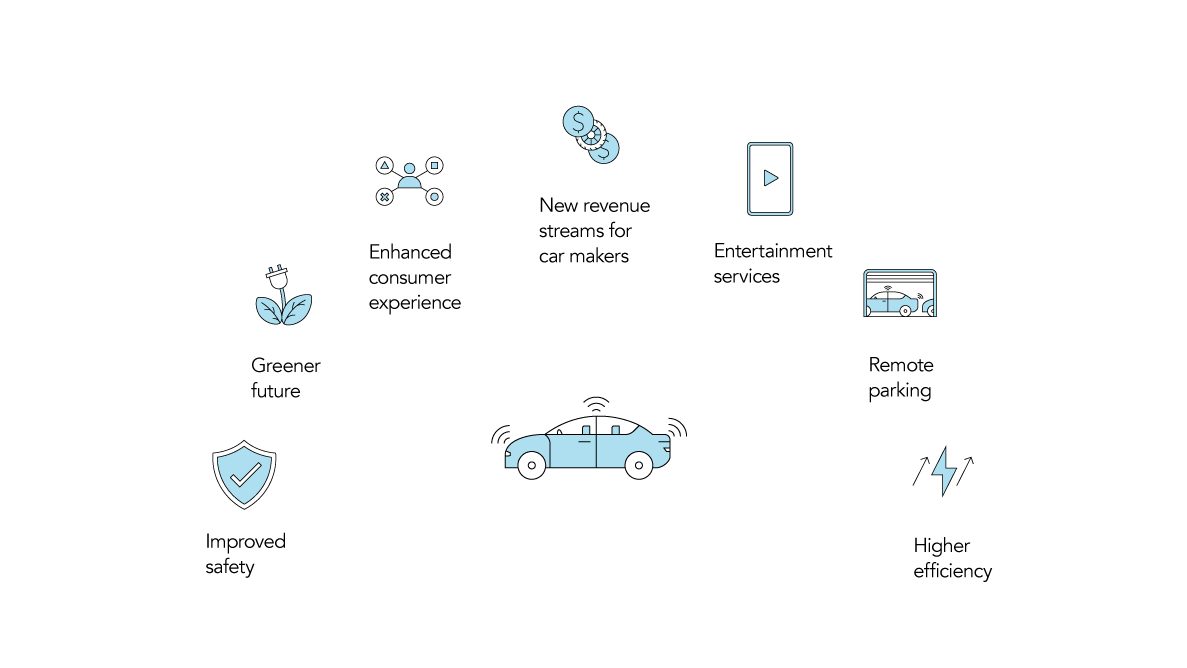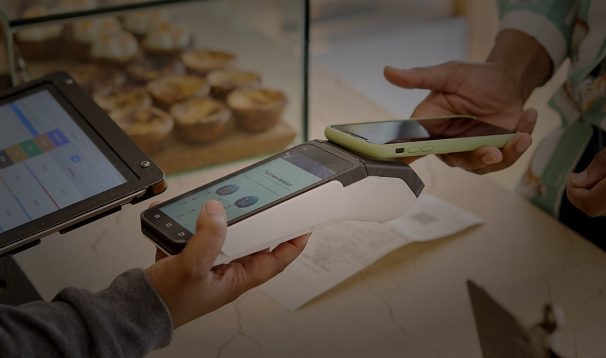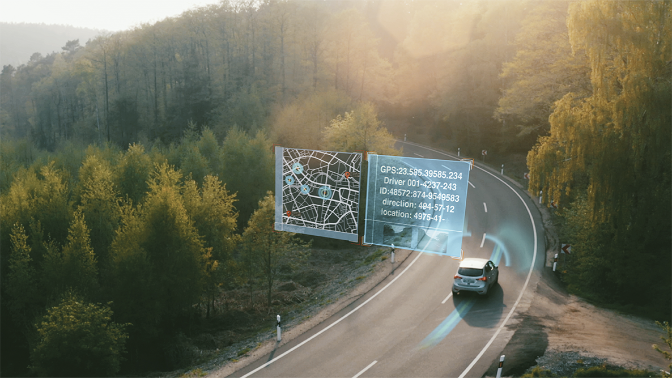Connected vehicles are on the rise and there is a good reason for this.
While previously, automakers mainly focused on the mechanical components of cars, modern drivers’ requirements demand augmented on-board systems, flexible connectivity, and infotainment. And, connected cars also offer the opportunity for drivers and passengers to bring their own world inside the vehicle. At its core, any vehicle/car which can connect to the internet and share it with devices inside and outside the car as well as external devices/services is called a Connected Car. In most cases, such vehicles connect to the internet via WLAN (Wireless Local Area Network).
Connected vehicles can always access the internet to perform functions/download data when requested by the user. This has turned a car into more of a personal device — an extension of consumers’ digital life, something like a smartphone on wheels. In essence, the modern car is becoming sensor-laden mobile IoT device with advanced communications systems focused on three areas:
- The surrounding environment (vehicle-to-everything or V2X communication)
- Vehicle location, engine diagnostics and vehicle activity (telematics) and driver behavior
- Vehicle’s occupants (infotainment)
The common thing for all these three systems is that they all use cellular, and 5G technology, among others.
To help you get a cleer overview of the latest trends, risk and opportunities connected vehicles can bring not only to automotive industry but the global market in general, we conducted a deep research into all the critical components around Connected vehicles and how they will shape the future of mobility. This article is the third in the series of of articles, Pushing the Frontiers of Automotive Industry.
Dive right in!
What are the benefits of connected vehicles?
Improved safety — UN claims that approximately 1.3 million people die every year due to traffic road accidents. With the introduction of Vehicle-to-everything, the communication between drivers, pedestrians and vehicles is brought to a much higher level which will further improve road safety for all parties.
Greener future — 5-G-enabled connected vehicles, specifically vehicle-to-infrastructure, will enable less traffic congestion in big cities. Through direct communication channels between vehicles and the city’s infrastructure, drivers will be notified when, for instance, they are approaching red light or a traffic jam which would then help them find the easiest and the quickest path to their destination, thus maximizing fuel economy and reducing emissions.
Enhanced consumer experience — According to McKinsey, 40 % of people will change their cars because they need more connected vehicles. Drivers are looking for more luxurious driving experience allowing them to enjoy all the comfort of their home.
New revenue streams for car makers — Connected vehicles powered by 5G offers car manufacturers a chance to go beyond just a point of sale and offer features like online service scheduling, predictive maintenance and remote diagnostics. This will further strengthen the connection with customers and provide unique customer experience.
Entertainment services — A connected vehicle will allow consumers to connect to a host of pre-loaded entertainment services/apps allowing them to watch videos when the car is parked, listen to music and internet radio.
Remote parking — Through connected vehicles, consumers can use their mobile phones to call a car, navigate their car to park, or send a car to park itself.
Higher efficiency — By using gathered data, connected vehicle can generate the most effective routes and enable consumers to avoid traffic jams and congested areas like streets under construction or busy street which would ultimately save them a huge amount of time. When it comes to fleets of vehicles, connected vehicles can help managers track their location as well as analyze their condition and increase their overall efficiency.

Trends
By 2030, about 95 percent of new vehicles sold globally will be connected, up from around 50 percent today.
A connected vehicle uses different types of connectivity and vehicle communication and this is where the convergence of IT and automotive comes to the stage. Here are the core communication technologies a connected vehicle is powered by:
Vehicle-to-Vehicle (V2V)
Vehicle-to-vehicle is a communication technology embedded in a connected car that can physically capture what is happening around the vehicle, share details on road conditions and proximity and communicate with other vehicles. In this case, information is shared in real time relying on the adoption of technologies like MEC (multi-access edge computing) and 5G to be able to meet the necessary speed for transferring information from vehicle to vehicle. This kind of vehicle communication helps drivers gain insight into traffic movement, speed limits, road conditions and so much more which does not only contribute to the future of mobility but it also increases the safety of vehicles.
Vehicle-to-Infrastructure (V2I)
Vehicle-to-infrastructure is a technology that connect vehicles to the infrastructure of the city such as traffic objects and roads and shares information including speed limits, accidents, traffic/road/weather conditions, etc. This type of vehicle is predominately used to improve the safety of the vehicle and its driver.
Vehicle-to-Cloud (V2C)
Using the wireless LTE network, the connected car can establish V2C connection. This solution relays data with the cloud and is mainly used for remote vehicle diagnostics, downloading over-the-air (OTA) vehicle updates, or to connect with any IoT devices.
Vehicle-to-Pedestrian (V2P)
One of the emerging trends of connected vehicles is Vehicle to Pedestrian system which is also aimed at improving safety on the roads. In this case, vehicles use sensors to detect pedestrians and provide drivers of collision warnings.
Vehicle-to-Everything (V2X)
All the above-mentioned types of connectivity merged into one, which is also known as V2X connectivity.
Three areas to focus on
The connected market is changing rapidly, but one thing is certain, auto makers and service providers can focus on the three key areas: infotainment, telematics and infrastructure.
Infotainment opportunities
Infotainment comprises a system that delivers information and in-car entertainment to drivers through audio and video interfaces which drives control using voice commands and screen displays. According to research by McKinsey & Company1, at the lower end, vehicles will be able to use a driver’s personal profile to access services on external digital platforms, such as Apple CarPlay and Android Auto.
On the other hand, McKinsey envisages that the user experience will shift from reactive to “intelligent and predictive” where drivers will be able to use “cognitive artificial intelligence systems” that would perform “highly complex communication and coordination tasks”. This would create a seamless user experience allowing drivers and passengers to use travel time to fulfil their personal tasks, have business meetings or watch personalised entertainment services. It will build a bridge between the drivers and passengers and the vehicle, giving real-time insight into functionality.
Automotive infotainment systems allow for the integration of automotive-specific applications developed by the community. This is similar to the trend we saw in the consumer industry, where smart TVs with app stores provided new opportunities for developers and users to access a wide range of content and services. Essentially, automotive infotainment systems are becoming more like smartphones, with a growing ecosystem of apps designed specifically for use while driving.
Telematics opportunities
Telematics technology connects the car to the cloud, allowing it to gather and share data on driver behaviour and car function. By gaining insight into this valuable data, manufacturers can have a clearer picture of performance and operational behaviour of vehicles and drivers can make smart decisions and discover many new opportunities.
Also, dealerships value telematics as it provides them with data on the consumer’s tire pressure, engine performance and enabling them to monitor smart maintenance service and vehicle diagnostics. Finally, this also helps manufacturers identify and mitigate risks that affect fleet, and it can also help fleet operators drive efficiency improvements and increase their revenue.
Infrastructure opportunities
Finally, infrastructure bridges the car and the environment, allowing the vehicle to perceive the presence of pedestrians, traffic lights and even communicate with the driver’s smart home. This kind of connectivity will be the key for future more resilient and efficient use of transport system. While it already supports shared mobility and electric vehicles, it will also play be a cornerstone of autonomous vehicles technology. It includes V2V (Vehicle-to-Vehicle), V2P (Vehicle-to-Pedestrian) and V2I (Vehicle-to-infrastructure) solutions.
Single account for all services
Another key trend to keep in mind is a single account for all services drivers use in connected vehicles.
We’re all familiar with the capabilities of today’s smart devices — smartphones or smartwatches allow us to exchange messages, respond to voice commands, and host a number of downloadable apps. Amazon Alexa and Google Assistant allow us to adjust the thermostat with a simple voice command or turn on lights in our home by using an app on our smartphone.
Similarly, with connected services in a car, automakers bring things to a higher level by bundling all of those capabilities and integrating them with vehicles. This allows users to use the same account for all the services they use, regardless of the platform. This means that users can have a consistent user experience across all their devices, including their cars, by simply logging in with their unique account.
This is particularly useful for people who frequently use rental cars or ride-sharing services, as they can easily access their preferred services and settings without having to manually configure each new device or vehicle they use. In short, connected cars are enabling a more seamless and personalized user experience across different platforms and devices.
Risks
As with every device that connects to the Internet, there is a risk of a potential cyber-attack that could have an adverse impact on automotive security. In essence, connected cars use cellular, satellite, Wi-Fi, Bluetooth, eSIM and RSD -based telematics, and other types of connectivity to send and receive data; this data supports a whole range of features and smart applications in a connected car that create new attack surfaces in connected cars.
Also, a connected car’s interactions with other vehicles, cloud services, and road infrastructure is another element of the overall security challenge. If neglected, this automotive security breach can have a very bad effect on the consumers’ trust, loyalty and their overall experience. High-risk attacks require only a limited understanding of how a connected vehicle works which allows an attacker who is not even that skilled at making cyber-security attacks to jeopardize the whole connected car system and therefore drivers’ safety.
Manipulation of safety-critical systems is one of the most dangerous manipulations as it allows hackers to control vehicle’s operation which can further have a detrimental effect on some ADAS features. Here are some other security risks for connected cars:
Personal data breaches
A connected car is becoming a smartphone on wheels. Sensors embedded in a vehicle gather massive amounts of data from vehicle’s systems including data on personal trips, entertainment preferences, and even financial information. These kinds of vehicles can be hacked as easily as smartphones.
Vehicle theft
Using digital keys, mobile apps and wireless key fobs, cyber attackers can easily gain unauthorized access to the car and steal it. This is why validation of “unlock” attempt and revocation must be handled carefully.
Connection risks
Since some vendors may not have paid enough attention to security during the design phase, this allows attackers to easily identify and exploit its vulnerabilities using Wi-Fi, physical connections and cellular networks.
Security vulnerabilities in supply chain
Automotive manufacturers rely heavily on a number of Tier 1, Tier 2 vendors as well as OEMs to supply systems, hardware and software components. Software coming from these vendors in most cases is a mix of custom code written by third-party code and the vendor. Unless car manufacturers do not create a set of requirements and impose them on suppliers, these components may be exposed to many vulnerabilities.
What’s next for connected vehicles
Connected cars are already making tectonic shifts in drivers’ experience and will only improve in the future. With the next-gen 5G technology, and 6G on its way, connected technology will play a key role in producing state-of-the-art vehicles that will heavily rely on data and offer features including safety features, driver assistance, entertainment, well-being and vehicle management.
Vehicles could receive rapid product updates over-the-air to improve their capabilities and users will be automatically connected to ecosystems which would allow them to have an overview of and manage traffic and road charging more easily.
On the business side, connected vehicle ecosystems will also soon enable the use of fully autonomous vehicles and offer decentralized fleet-management and predictive maintenance, while improving condition monitoring, predictive analytics and optimized fuel/hydrogen/electricity consumption. This will result in a gradual move towards a vehicle-as-a-service model, where subscription models will come to the stage.
The benefits of connected vehicles are obvious. Needless to say, the Internet of Things (IoT), Edge Computing and Cloud Computing will be at the center of all this to enable this technology shift.
Also, the connected car technology will not only have impact on conventional cars. Self-driving vehicles will also use this technology to communicate with the cloud system and road infrastructure.
Reimagining the future of connected vehicles with a differentiated approach
With Connected car technologies reimagining the driving experience, OEMs and Tier 1 companies are going through a dramatic digital transformation that’s impacting the entire automotive industry and the whole global market. Car manufacturers see great opportunities in connected car software development – as well as technological challenges that we at HTEC Group help them solve leveraging our deep understanding of the industry and valuable experience we have gained over the years. Here are some key areas where we can deliver value:

Importance of in-vehicle infotainment
Personalization of connected car provides differentiated experiences to end users. A car that knows the driver’s identity and is able to provide a differential experience will, ultimately, stand out in terms of personalization. This is where in-car infotainment plays an important role in achieving the maximum personalization level.

Let us help you reimagine success in connected vehicles
As customer preferences shape the automotive sector, most innovations today are demand-driven which means that most of the car technology is software and data driven. Both car manufacturers and other software companies see great opportunities in connected car software solutions and increasingly looking for software vendors that provide top-notch connected vehicle services. They are working on effective solutions for collecting, processing, structuring, and visualization of massive loads of real-time vehicle- and sensor- external data to create groundbreaking autonomous driving solutions that will help them get ahead of the curve.
There are many opportunities for OEMs, fleet owners, dealerships, and suppliers to realize greater value on the investments they’ve made in sensors and connected vehicles. Reach out to one of our experts, Tihomir Anđelić, Stevica Đukić, or Stefan Končar and let us help you take command of the road ahead.
To learn more about how we can help you shape the future of mobility, check out our recent blogs:
Why Is the Automotive Future Electric?, and What’s Next for Autonomous Driving?














